NSB132 Integrated Nursing Practice: Fracture Pain - Comparative Essay
VerifiedAdded on 2022/10/08
|7
|2491
|43
Essay
AI Summary
This essay analyzes two case studies, a 7-year-old boy and a 72-year-old man, both with fractured tibias, to compare and contrast their responses to pain and the subsequent nursing interventions required. The essay explores the underlying pathophysiology of fractures, emphasizing the differences in pain assessment based on chronological and developmental age, including the use of the FLACC score for the child and verbal pain scales for the elderly patient. It details the care goals of reducing pain to zero and outlines evidence-based interventions such as immobilization and elevation. The essay further compares methods to evaluate the effectiveness of these interventions, highlighting the behavioral approach for the child versus the verbal description for the elderly patient. The document also includes references to support the evidence-based practice.

UNIT:
NAME:
DATE:
NAME:
DATE:
Paraphrase This Document
Need a fresh take? Get an instant paraphrase of this document with our AI Paraphraser
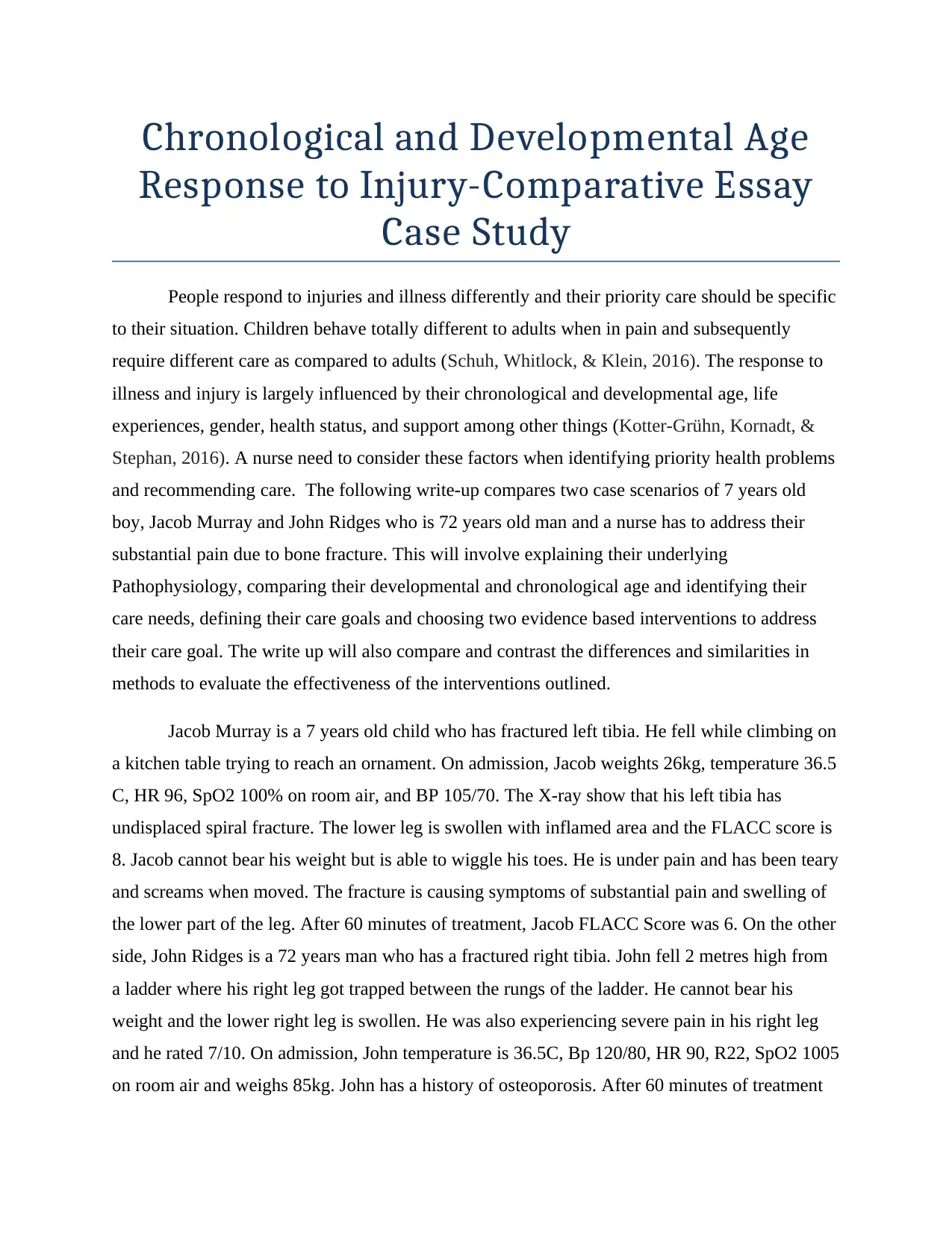
Chronological and Developmental Age
Response to Injury-Comparative Essay
Case Study
People respond to injuries and illness differently and their priority care should be specific
to their situation. Children behave totally different to adults when in pain and subsequently
require different care as compared to adults (Schuh, Whitlock, & Klein, 2016). The response to
illness and injury is largely influenced by their chronological and developmental age, life
experiences, gender, health status, and support among other things (Kotter-Grühn, Kornadt, &
Stephan, 2016). A nurse need to consider these factors when identifying priority health problems
and recommending care. The following write-up compares two case scenarios of 7 years old
boy, Jacob Murray and John Ridges who is 72 years old man and a nurse has to address their
substantial pain due to bone fracture. This will involve explaining their underlying
Pathophysiology, comparing their developmental and chronological age and identifying their
care needs, defining their care goals and choosing two evidence based interventions to address
their care goal. The write up will also compare and contrast the differences and similarities in
methods to evaluate the effectiveness of the interventions outlined.
Jacob Murray is a 7 years old child who has fractured left tibia. He fell while climbing on
a kitchen table trying to reach an ornament. On admission, Jacob weights 26kg, temperature 36.5
C, HR 96, SpO2 100% on room air, and BP 105/70. The X-ray show that his left tibia has
undisplaced spiral fracture. The lower leg is swollen with inflamed area and the FLACC score is
8. Jacob cannot bear his weight but is able to wiggle his toes. He is under pain and has been teary
and screams when moved. The fracture is causing symptoms of substantial pain and swelling of
the lower part of the leg. After 60 minutes of treatment, Jacob FLACC Score was 6. On the other
side, John Ridges is a 72 years man who has a fractured right tibia. John fell 2 metres high from
a ladder where his right leg got trapped between the rungs of the ladder. He cannot bear his
weight and the lower right leg is swollen. He was also experiencing severe pain in his right leg
and he rated 7/10. On admission, John temperature is 36.5C, Bp 120/80, HR 90, R22, SpO2 1005
on room air and weighs 85kg. John has a history of osteoporosis. After 60 minutes of treatment
Response to Injury-Comparative Essay
Case Study
People respond to injuries and illness differently and their priority care should be specific
to their situation. Children behave totally different to adults when in pain and subsequently
require different care as compared to adults (Schuh, Whitlock, & Klein, 2016). The response to
illness and injury is largely influenced by their chronological and developmental age, life
experiences, gender, health status, and support among other things (Kotter-Grühn, Kornadt, &
Stephan, 2016). A nurse need to consider these factors when identifying priority health problems
and recommending care. The following write-up compares two case scenarios of 7 years old
boy, Jacob Murray and John Ridges who is 72 years old man and a nurse has to address their
substantial pain due to bone fracture. This will involve explaining their underlying
Pathophysiology, comparing their developmental and chronological age and identifying their
care needs, defining their care goals and choosing two evidence based interventions to address
their care goal. The write up will also compare and contrast the differences and similarities in
methods to evaluate the effectiveness of the interventions outlined.
Jacob Murray is a 7 years old child who has fractured left tibia. He fell while climbing on
a kitchen table trying to reach an ornament. On admission, Jacob weights 26kg, temperature 36.5
C, HR 96, SpO2 100% on room air, and BP 105/70. The X-ray show that his left tibia has
undisplaced spiral fracture. The lower leg is swollen with inflamed area and the FLACC score is
8. Jacob cannot bear his weight but is able to wiggle his toes. He is under pain and has been teary
and screams when moved. The fracture is causing symptoms of substantial pain and swelling of
the lower part of the leg. After 60 minutes of treatment, Jacob FLACC Score was 6. On the other
side, John Ridges is a 72 years man who has a fractured right tibia. John fell 2 metres high from
a ladder where his right leg got trapped between the rungs of the ladder. He cannot bear his
weight and the lower right leg is swollen. He was also experiencing severe pain in his right leg
and he rated 7/10. On admission, John temperature is 36.5C, Bp 120/80, HR 90, R22, SpO2 1005
on room air and weighs 85kg. John has a history of osteoporosis. After 60 minutes of treatment
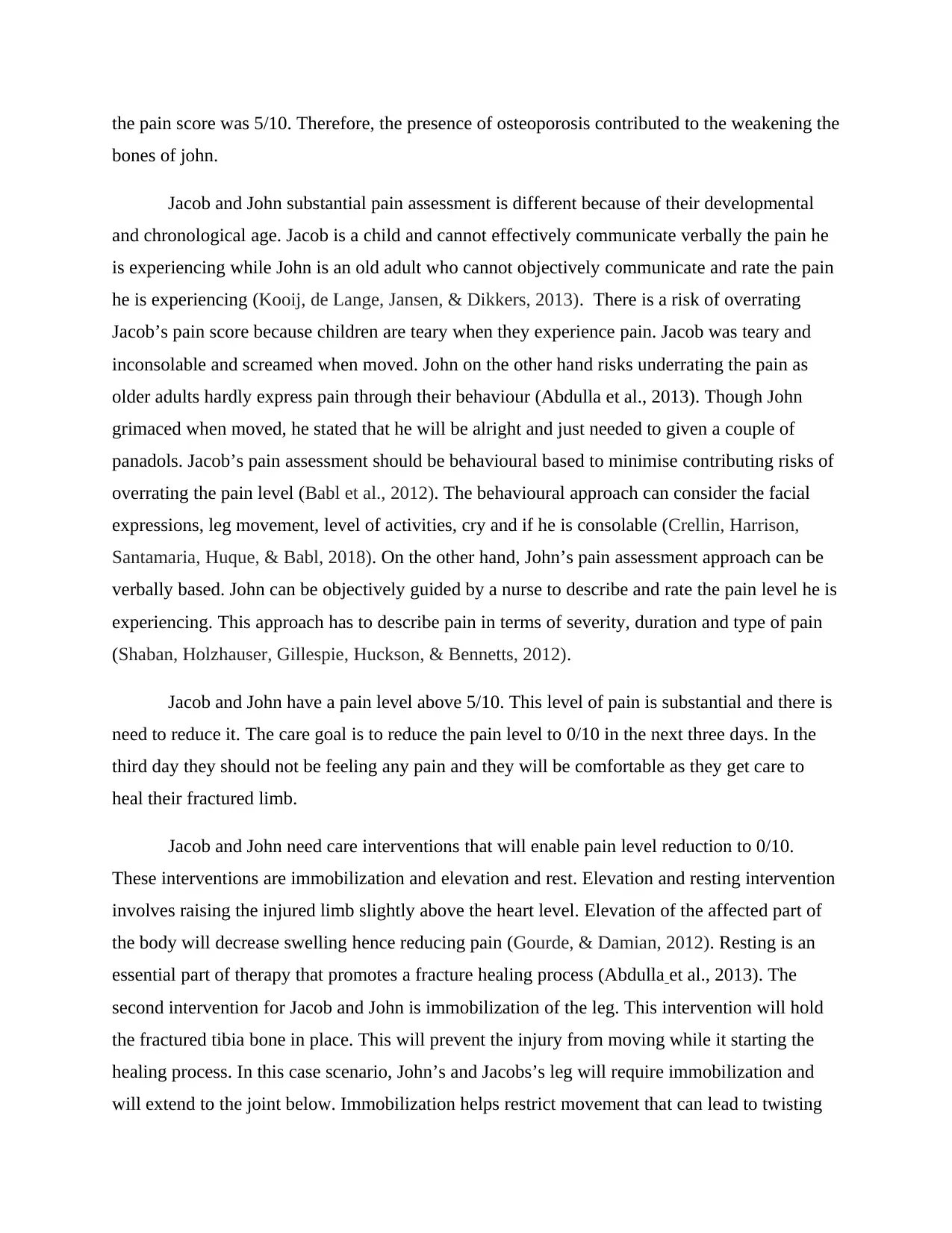
the pain score was 5/10. Therefore, the presence of osteoporosis contributed to the weakening the
bones of john.
Jacob and John substantial pain assessment is different because of their developmental
and chronological age. Jacob is a child and cannot effectively communicate verbally the pain he
is experiencing while John is an old adult who cannot objectively communicate and rate the pain
he is experiencing (Kooij, de Lange, Jansen, & Dikkers, 2013). There is a risk of overrating
Jacob’s pain score because children are teary when they experience pain. Jacob was teary and
inconsolable and screamed when moved. John on the other hand risks underrating the pain as
older adults hardly express pain through their behaviour (Abdulla et al., 2013). Though John
grimaced when moved, he stated that he will be alright and just needed to given a couple of
panadols. Jacob’s pain assessment should be behavioural based to minimise contributing risks of
overrating the pain level (Babl et al., 2012). The behavioural approach can consider the facial
expressions, leg movement, level of activities, cry and if he is consolable (Crellin, Harrison,
Santamaria, Huque, & Babl, 2018). On the other hand, John’s pain assessment approach can be
verbally based. John can be objectively guided by a nurse to describe and rate the pain level he is
experiencing. This approach has to describe pain in terms of severity, duration and type of pain
(Shaban, Holzhauser, Gillespie, Huckson, & Bennetts, 2012).
Jacob and John have a pain level above 5/10. This level of pain is substantial and there is
need to reduce it. The care goal is to reduce the pain level to 0/10 in the next three days. In the
third day they should not be feeling any pain and they will be comfortable as they get care to
heal their fractured limb.
Jacob and John need care interventions that will enable pain level reduction to 0/10.
These interventions are immobilization and elevation and rest. Elevation and resting intervention
involves raising the injured limb slightly above the heart level. Elevation of the affected part of
the body will decrease swelling hence reducing pain (Gourde, & Damian, 2012). Resting is an
essential part of therapy that promotes a fracture healing process (Abdulla et al., 2013). The
second intervention for Jacob and John is immobilization of the leg. This intervention will hold
the fractured tibia bone in place. This will prevent the injury from moving while it starting the
healing process. In this case scenario, John’s and Jacobs’s leg will require immobilization and
will extend to the joint below. Immobilization helps restrict movement that can lead to twisting
bones of john.
Jacob and John substantial pain assessment is different because of their developmental
and chronological age. Jacob is a child and cannot effectively communicate verbally the pain he
is experiencing while John is an old adult who cannot objectively communicate and rate the pain
he is experiencing (Kooij, de Lange, Jansen, & Dikkers, 2013). There is a risk of overrating
Jacob’s pain score because children are teary when they experience pain. Jacob was teary and
inconsolable and screamed when moved. John on the other hand risks underrating the pain as
older adults hardly express pain through their behaviour (Abdulla et al., 2013). Though John
grimaced when moved, he stated that he will be alright and just needed to given a couple of
panadols. Jacob’s pain assessment should be behavioural based to minimise contributing risks of
overrating the pain level (Babl et al., 2012). The behavioural approach can consider the facial
expressions, leg movement, level of activities, cry and if he is consolable (Crellin, Harrison,
Santamaria, Huque, & Babl, 2018). On the other hand, John’s pain assessment approach can be
verbally based. John can be objectively guided by a nurse to describe and rate the pain level he is
experiencing. This approach has to describe pain in terms of severity, duration and type of pain
(Shaban, Holzhauser, Gillespie, Huckson, & Bennetts, 2012).
Jacob and John have a pain level above 5/10. This level of pain is substantial and there is
need to reduce it. The care goal is to reduce the pain level to 0/10 in the next three days. In the
third day they should not be feeling any pain and they will be comfortable as they get care to
heal their fractured limb.
Jacob and John need care interventions that will enable pain level reduction to 0/10.
These interventions are immobilization and elevation and rest. Elevation and resting intervention
involves raising the injured limb slightly above the heart level. Elevation of the affected part of
the body will decrease swelling hence reducing pain (Gourde, & Damian, 2012). Resting is an
essential part of therapy that promotes a fracture healing process (Abdulla et al., 2013). The
second intervention for Jacob and John is immobilization of the leg. This intervention will hold
the fractured tibia bone in place. This will prevent the injury from moving while it starting the
healing process. In this case scenario, John’s and Jacobs’s leg will require immobilization and
will extend to the joint below. Immobilization helps restrict movement that can lead to twisting
⊘ This is a preview!⊘
Do you want full access?
Subscribe today to unlock all pages.

Trusted by 1+ million students worldwide
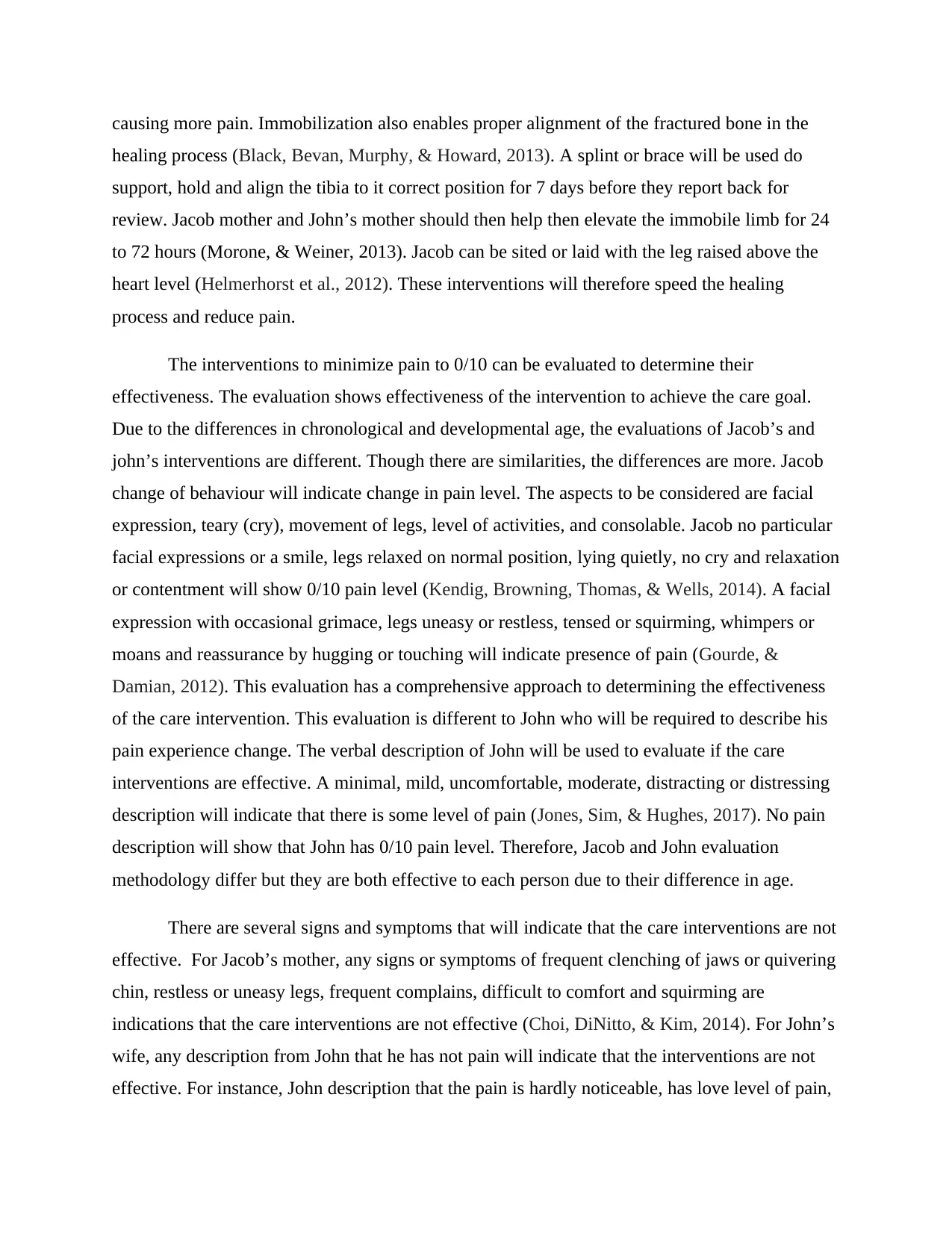
causing more pain. Immobilization also enables proper alignment of the fractured bone in the
healing process (Black, Bevan, Murphy, & Howard, 2013). A splint or brace will be used do
support, hold and align the tibia to it correct position for 7 days before they report back for
review. Jacob mother and John’s mother should then help then elevate the immobile limb for 24
to 72 hours (Morone, & Weiner, 2013). Jacob can be sited or laid with the leg raised above the
heart level (Helmerhorst et al., 2012). These interventions will therefore speed the healing
process and reduce pain.
The interventions to minimize pain to 0/10 can be evaluated to determine their
effectiveness. The evaluation shows effectiveness of the intervention to achieve the care goal.
Due to the differences in chronological and developmental age, the evaluations of Jacob’s and
john’s interventions are different. Though there are similarities, the differences are more. Jacob
change of behaviour will indicate change in pain level. The aspects to be considered are facial
expression, teary (cry), movement of legs, level of activities, and consolable. Jacob no particular
facial expressions or a smile, legs relaxed on normal position, lying quietly, no cry and relaxation
or contentment will show 0/10 pain level (Kendig, Browning, Thomas, & Wells, 2014). A facial
expression with occasional grimace, legs uneasy or restless, tensed or squirming, whimpers or
moans and reassurance by hugging or touching will indicate presence of pain (Gourde, &
Damian, 2012). This evaluation has a comprehensive approach to determining the effectiveness
of the care intervention. This evaluation is different to John who will be required to describe his
pain experience change. The verbal description of John will be used to evaluate if the care
interventions are effective. A minimal, mild, uncomfortable, moderate, distracting or distressing
description will indicate that there is some level of pain (Jones, Sim, & Hughes, 2017). No pain
description will show that John has 0/10 pain level. Therefore, Jacob and John evaluation
methodology differ but they are both effective to each person due to their difference in age.
There are several signs and symptoms that will indicate that the care interventions are not
effective. For Jacob’s mother, any signs or symptoms of frequent clenching of jaws or quivering
chin, restless or uneasy legs, frequent complains, difficult to comfort and squirming are
indications that the care interventions are not effective (Choi, DiNitto, & Kim, 2014). For John’s
wife, any description from John that he has not pain will indicate that the interventions are not
effective. For instance, John description that the pain is hardly noticeable, has love level of pain,
healing process (Black, Bevan, Murphy, & Howard, 2013). A splint or brace will be used do
support, hold and align the tibia to it correct position for 7 days before they report back for
review. Jacob mother and John’s mother should then help then elevate the immobile limb for 24
to 72 hours (Morone, & Weiner, 2013). Jacob can be sited or laid with the leg raised above the
heart level (Helmerhorst et al., 2012). These interventions will therefore speed the healing
process and reduce pain.
The interventions to minimize pain to 0/10 can be evaluated to determine their
effectiveness. The evaluation shows effectiveness of the intervention to achieve the care goal.
Due to the differences in chronological and developmental age, the evaluations of Jacob’s and
john’s interventions are different. Though there are similarities, the differences are more. Jacob
change of behaviour will indicate change in pain level. The aspects to be considered are facial
expression, teary (cry), movement of legs, level of activities, and consolable. Jacob no particular
facial expressions or a smile, legs relaxed on normal position, lying quietly, no cry and relaxation
or contentment will show 0/10 pain level (Kendig, Browning, Thomas, & Wells, 2014). A facial
expression with occasional grimace, legs uneasy or restless, tensed or squirming, whimpers or
moans and reassurance by hugging or touching will indicate presence of pain (Gourde, &
Damian, 2012). This evaluation has a comprehensive approach to determining the effectiveness
of the care intervention. This evaluation is different to John who will be required to describe his
pain experience change. The verbal description of John will be used to evaluate if the care
interventions are effective. A minimal, mild, uncomfortable, moderate, distracting or distressing
description will indicate that there is some level of pain (Jones, Sim, & Hughes, 2017). No pain
description will show that John has 0/10 pain level. Therefore, Jacob and John evaluation
methodology differ but they are both effective to each person due to their difference in age.
There are several signs and symptoms that will indicate that the care interventions are not
effective. For Jacob’s mother, any signs or symptoms of frequent clenching of jaws or quivering
chin, restless or uneasy legs, frequent complains, difficult to comfort and squirming are
indications that the care interventions are not effective (Choi, DiNitto, & Kim, 2014). For John’s
wife, any description from John that he has not pain will indicate that the interventions are not
effective. For instance, John description that the pain is hardly noticeable, has love level of pain,
Paraphrase This Document
Need a fresh take? Get an instant paraphrase of this document with our AI Paraphraser
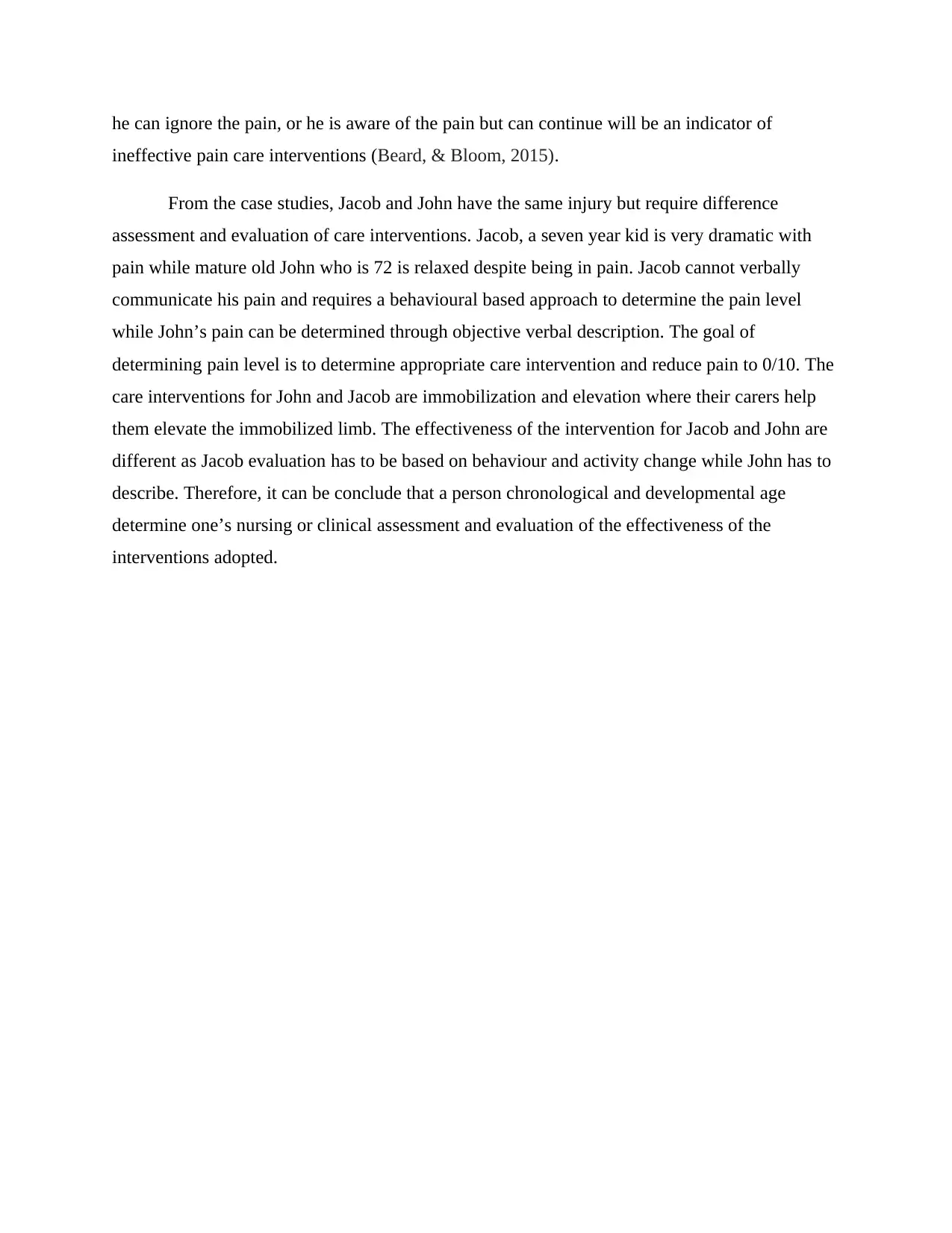
he can ignore the pain, or he is aware of the pain but can continue will be an indicator of
ineffective pain care interventions (Beard, & Bloom, 2015).
From the case studies, Jacob and John have the same injury but require difference
assessment and evaluation of care interventions. Jacob, a seven year kid is very dramatic with
pain while mature old John who is 72 is relaxed despite being in pain. Jacob cannot verbally
communicate his pain and requires a behavioural based approach to determine the pain level
while John’s pain can be determined through objective verbal description. The goal of
determining pain level is to determine appropriate care intervention and reduce pain to 0/10. The
care interventions for John and Jacob are immobilization and elevation where their carers help
them elevate the immobilized limb. The effectiveness of the intervention for Jacob and John are
different as Jacob evaluation has to be based on behaviour and activity change while John has to
describe. Therefore, it can be conclude that a person chronological and developmental age
determine one’s nursing or clinical assessment and evaluation of the effectiveness of the
interventions adopted.
ineffective pain care interventions (Beard, & Bloom, 2015).
From the case studies, Jacob and John have the same injury but require difference
assessment and evaluation of care interventions. Jacob, a seven year kid is very dramatic with
pain while mature old John who is 72 is relaxed despite being in pain. Jacob cannot verbally
communicate his pain and requires a behavioural based approach to determine the pain level
while John’s pain can be determined through objective verbal description. The goal of
determining pain level is to determine appropriate care intervention and reduce pain to 0/10. The
care interventions for John and Jacob are immobilization and elevation where their carers help
them elevate the immobilized limb. The effectiveness of the intervention for Jacob and John are
different as Jacob evaluation has to be based on behaviour and activity change while John has to
describe. Therefore, it can be conclude that a person chronological and developmental age
determine one’s nursing or clinical assessment and evaluation of the effectiveness of the
interventions adopted.
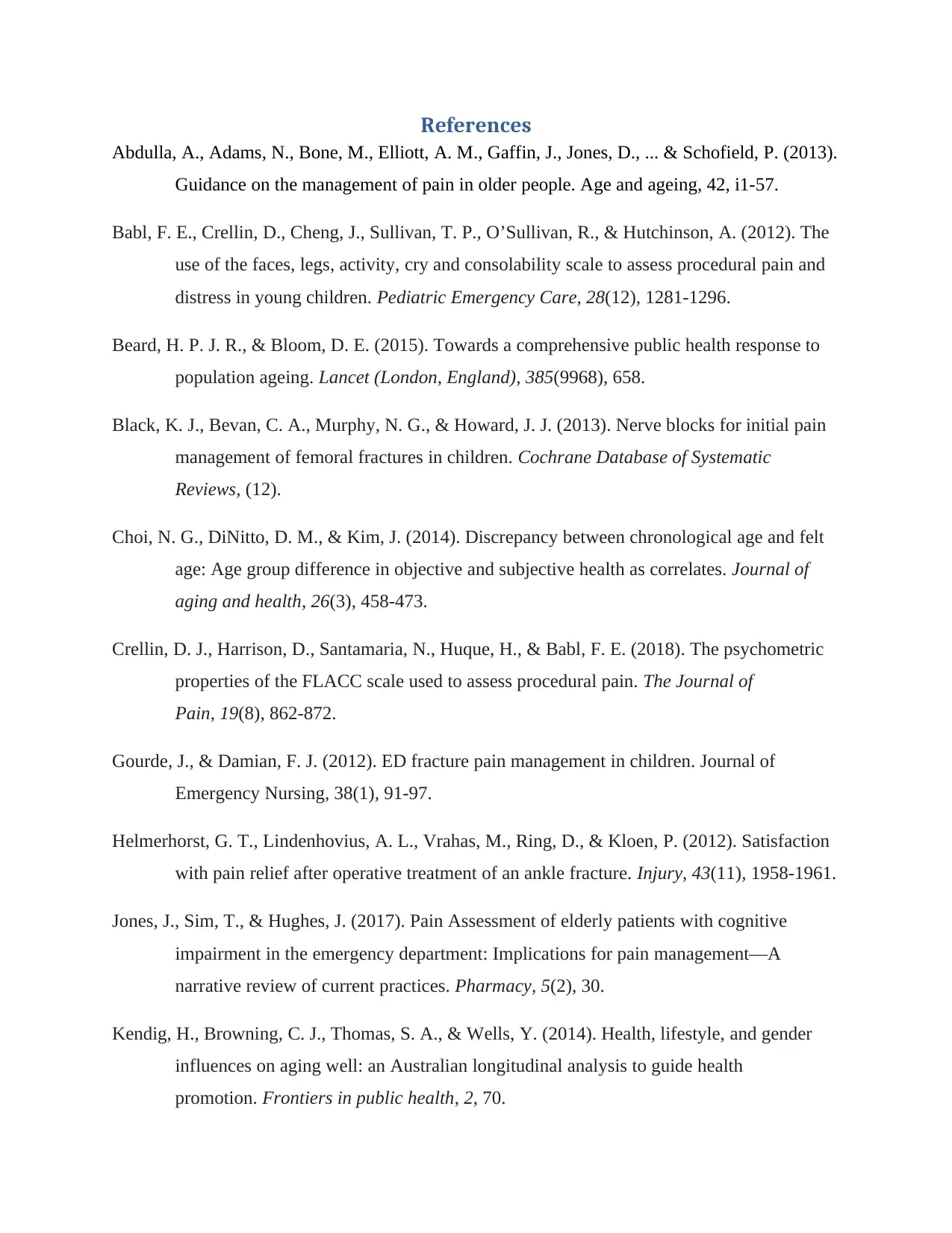
References
Abdulla, A., Adams, N., Bone, M., Elliott, A. M., Gaffin, J., Jones, D., ... & Schofield, P. (2013).
Guidance on the management of pain in older people. Age and ageing, 42, i1-57.
Babl, F. E., Crellin, D., Cheng, J., Sullivan, T. P., O’Sullivan, R., & Hutchinson, A. (2012). The
use of the faces, legs, activity, cry and consolability scale to assess procedural pain and
distress in young children. Pediatric Emergency Care, 28(12), 1281-1296.
Beard, H. P. J. R., & Bloom, D. E. (2015). Towards a comprehensive public health response to
population ageing. Lancet (London, England), 385(9968), 658.
Black, K. J., Bevan, C. A., Murphy, N. G., & Howard, J. J. (2013). Nerve blocks for initial pain
management of femoral fractures in children. Cochrane Database of Systematic
Reviews, (12).
Choi, N. G., DiNitto, D. M., & Kim, J. (2014). Discrepancy between chronological age and felt
age: Age group difference in objective and subjective health as correlates. Journal of
aging and health, 26(3), 458-473.
Crellin, D. J., Harrison, D., Santamaria, N., Huque, H., & Babl, F. E. (2018). The psychometric
properties of the FLACC scale used to assess procedural pain. The Journal of
Pain, 19(8), 862-872.
Gourde, J., & Damian, F. J. (2012). ED fracture pain management in children. Journal of
Emergency Nursing, 38(1), 91-97.
Helmerhorst, G. T., Lindenhovius, A. L., Vrahas, M., Ring, D., & Kloen, P. (2012). Satisfaction
with pain relief after operative treatment of an ankle fracture. Injury, 43(11), 1958-1961.
Jones, J., Sim, T., & Hughes, J. (2017). Pain Assessment of elderly patients with cognitive
impairment in the emergency department: Implications for pain management—A
narrative review of current practices. Pharmacy, 5(2), 30.
Kendig, H., Browning, C. J., Thomas, S. A., & Wells, Y. (2014). Health, lifestyle, and gender
influences on aging well: an Australian longitudinal analysis to guide health
promotion. Frontiers in public health, 2, 70.
Abdulla, A., Adams, N., Bone, M., Elliott, A. M., Gaffin, J., Jones, D., ... & Schofield, P. (2013).
Guidance on the management of pain in older people. Age and ageing, 42, i1-57.
Babl, F. E., Crellin, D., Cheng, J., Sullivan, T. P., O’Sullivan, R., & Hutchinson, A. (2012). The
use of the faces, legs, activity, cry and consolability scale to assess procedural pain and
distress in young children. Pediatric Emergency Care, 28(12), 1281-1296.
Beard, H. P. J. R., & Bloom, D. E. (2015). Towards a comprehensive public health response to
population ageing. Lancet (London, England), 385(9968), 658.
Black, K. J., Bevan, C. A., Murphy, N. G., & Howard, J. J. (2013). Nerve blocks for initial pain
management of femoral fractures in children. Cochrane Database of Systematic
Reviews, (12).
Choi, N. G., DiNitto, D. M., & Kim, J. (2014). Discrepancy between chronological age and felt
age: Age group difference in objective and subjective health as correlates. Journal of
aging and health, 26(3), 458-473.
Crellin, D. J., Harrison, D., Santamaria, N., Huque, H., & Babl, F. E. (2018). The psychometric
properties of the FLACC scale used to assess procedural pain. The Journal of
Pain, 19(8), 862-872.
Gourde, J., & Damian, F. J. (2012). ED fracture pain management in children. Journal of
Emergency Nursing, 38(1), 91-97.
Helmerhorst, G. T., Lindenhovius, A. L., Vrahas, M., Ring, D., & Kloen, P. (2012). Satisfaction
with pain relief after operative treatment of an ankle fracture. Injury, 43(11), 1958-1961.
Jones, J., Sim, T., & Hughes, J. (2017). Pain Assessment of elderly patients with cognitive
impairment in the emergency department: Implications for pain management—A
narrative review of current practices. Pharmacy, 5(2), 30.
Kendig, H., Browning, C. J., Thomas, S. A., & Wells, Y. (2014). Health, lifestyle, and gender
influences on aging well: an Australian longitudinal analysis to guide health
promotion. Frontiers in public health, 2, 70.
⊘ This is a preview!⊘
Do you want full access?
Subscribe today to unlock all pages.

Trusted by 1+ million students worldwide
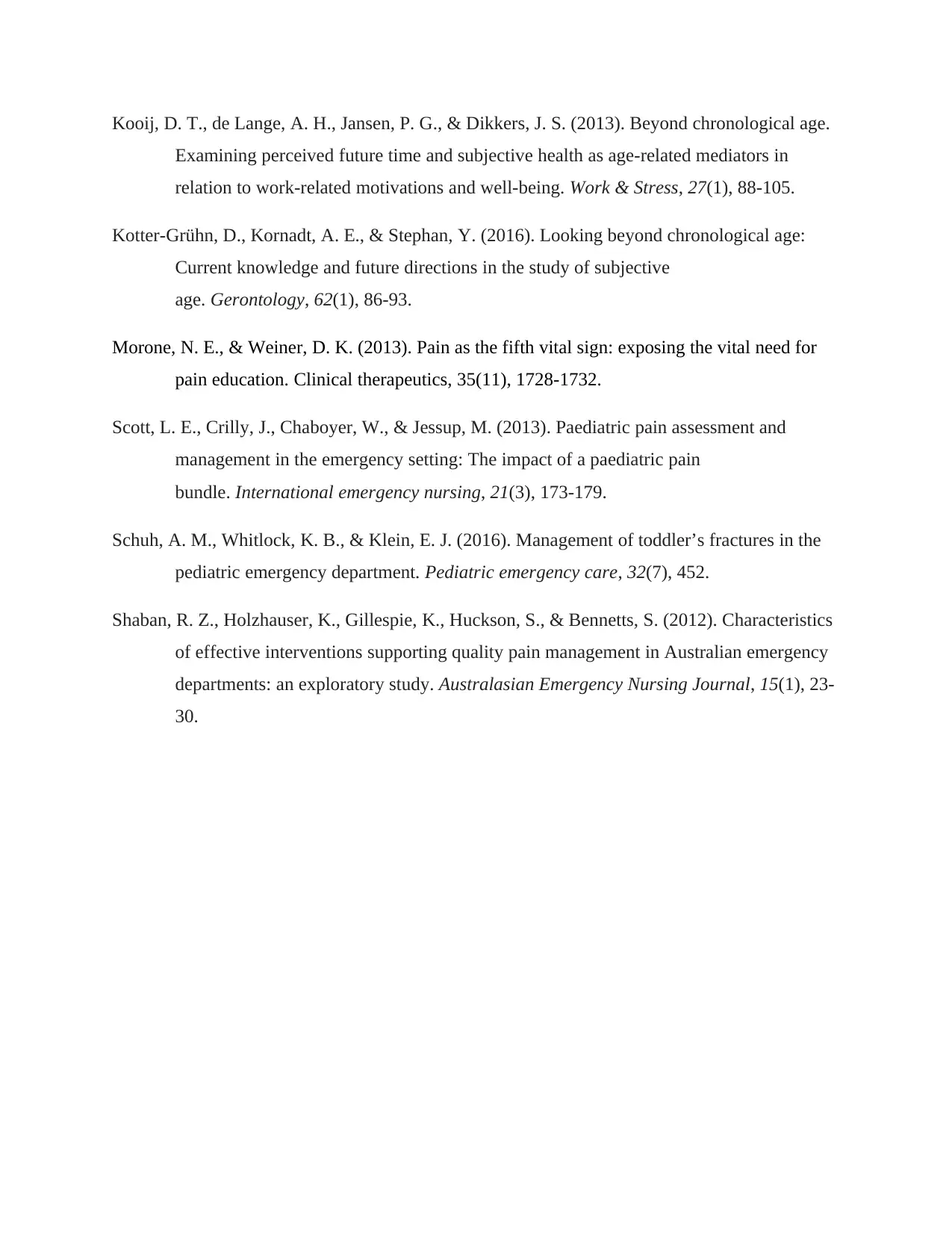
Kooij, D. T., de Lange, A. H., Jansen, P. G., & Dikkers, J. S. (2013). Beyond chronological age.
Examining perceived future time and subjective health as age-related mediators in
relation to work-related motivations and well-being. Work & Stress, 27(1), 88-105.
Kotter-Grühn, D., Kornadt, A. E., & Stephan, Y. (2016). Looking beyond chronological age:
Current knowledge and future directions in the study of subjective
age. Gerontology, 62(1), 86-93.
Morone, N. E., & Weiner, D. K. (2013). Pain as the fifth vital sign: exposing the vital need for
pain education. Clinical therapeutics, 35(11), 1728-1732.
Scott, L. E., Crilly, J., Chaboyer, W., & Jessup, M. (2013). Paediatric pain assessment and
management in the emergency setting: The impact of a paediatric pain
bundle. International emergency nursing, 21(3), 173-179.
Schuh, A. M., Whitlock, K. B., & Klein, E. J. (2016). Management of toddler’s fractures in the
pediatric emergency department. Pediatric emergency care, 32(7), 452.
Shaban, R. Z., Holzhauser, K., Gillespie, K., Huckson, S., & Bennetts, S. (2012). Characteristics
of effective interventions supporting quality pain management in Australian emergency
departments: an exploratory study. Australasian Emergency Nursing Journal, 15(1), 23-
30.
Examining perceived future time and subjective health as age-related mediators in
relation to work-related motivations and well-being. Work & Stress, 27(1), 88-105.
Kotter-Grühn, D., Kornadt, A. E., & Stephan, Y. (2016). Looking beyond chronological age:
Current knowledge and future directions in the study of subjective
age. Gerontology, 62(1), 86-93.
Morone, N. E., & Weiner, D. K. (2013). Pain as the fifth vital sign: exposing the vital need for
pain education. Clinical therapeutics, 35(11), 1728-1732.
Scott, L. E., Crilly, J., Chaboyer, W., & Jessup, M. (2013). Paediatric pain assessment and
management in the emergency setting: The impact of a paediatric pain
bundle. International emergency nursing, 21(3), 173-179.
Schuh, A. M., Whitlock, K. B., & Klein, E. J. (2016). Management of toddler’s fractures in the
pediatric emergency department. Pediatric emergency care, 32(7), 452.
Shaban, R. Z., Holzhauser, K., Gillespie, K., Huckson, S., & Bennetts, S. (2012). Characteristics
of effective interventions supporting quality pain management in Australian emergency
departments: an exploratory study. Australasian Emergency Nursing Journal, 15(1), 23-
30.
1 out of 7
Your All-in-One AI-Powered Toolkit for Academic Success.
+13062052269
info@desklib.com
Available 24*7 on WhatsApp / Email
![[object Object]](/_next/static/media/star-bottom.7253800d.svg)
Unlock your academic potential
Copyright © 2020–2025 A2Z Services. All Rights Reserved. Developed and managed by ZUCOL.

